Today I’m going to show you how to get a livable income stream from a $300,000 nest egg—while growing your savings at the same time.
Sounds impossible, right?
Wrong.
What’s more, we’re going to pull it off using just six funds. When we’re done, we’ll end up with a simple, diversified portfolio that throws off a nice, steady 7.9% dividend yield!
And if you’re worried that this outsized yield could come at the cost of a weak total return, don’t be, because these funds have delivered 12% per year over the past decade.
Before I get into these six funds, let me show you what numbers like these can mean for you: if we start with an upfront investment of $305,000 in this portfolio and leave it alone for 10 years, we can expect our capital to explode to nearly $1 million in a decade.
History tells the tale: if you had invested $305,000 in these funds 10 years ago, you would have done just that.
The Power of a 12% Total Return
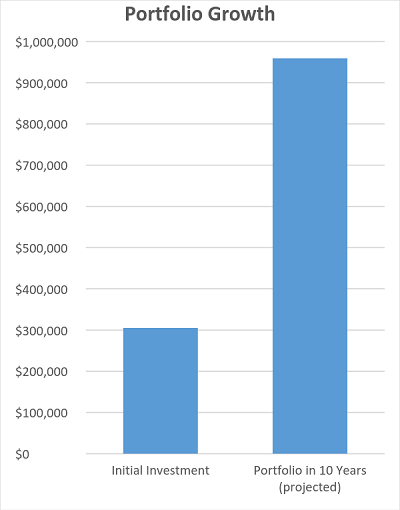
Now I’m not saying history is going to repeat exactly here, but remember that we’re talking total returns in the chart above, and much of that gain came in the form of dividends.
We can expect those hefty payouts to continue. As I said off the top, this portfolio has a 7.9% yield, meaning our $305,000 initial investment is going to give us $24,000 in annual income—that’s $2,000 per month!
Granted, many Americans make more than that in a year, so you may not be able to completely replace your income with this cash stream. But some folks could. In some parts of the country, average incomes do go down to $24,000, and with rents for one-bedroom apartments falling below $600 in some cities (like Wichita, Cleveland, Tucson, El Paso and Albuquerque), it is possible to live entirely on this income stream.
But even if you can’t live on $2,000 a month, this portfolio could hand you a nice, reliable supplementary income stream, leaving you much less reliant on the 9-to-5 grind.
So how does the portfolio work?
Connecting the Pieces
The six funds I’m talking about come from four management firms with impressive track records: PIMCO, John Hancock, Columbia Management and Flaherty & Crumrine.
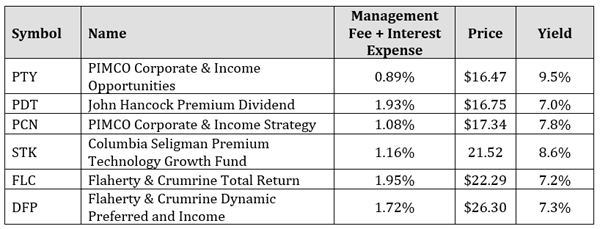
Together, they hand you exposure to over 300 firms through stocks and bonds. On top of that, the Columbia Seligman Premium Technology Growth Fund uses an insurance strategy that protects you from a bear market by selling call options on the its equity portfolio. (My colleague Brett Owens explained how this works—and why it cuts your risk—in a February 22 article you can read here.)
And of course, by throwing $305,000 into this group of six funds, we can earn a monthly income a smidgen over $2,000 on this portfolio:
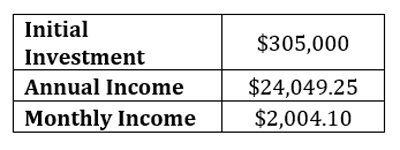
Surely with such high yields, you’re going to sacrifice capital gains, right? In many cases, this is a tradeoff investors need to make, but these funds have performed tremendously, with annualized gains exceeding 9%—and the best ones rising over 13.5% per year:
Income and Growth in 6 Easy Buys
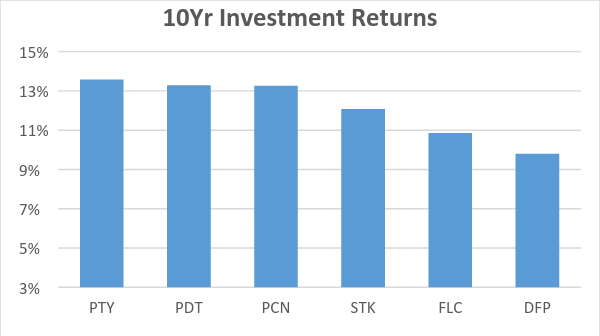
Those gains are what allowed our $305,000 to balloon to $959,000 if e chose to keep these funds and save the cash they yielded in dividends.
With numbers like these, you might be asking yourself why hardly anyone is talking about these funds.
The answer: these six funds are known as closed-end funds, which are an obscure corner of the market (I explain exactly how CEFs work, and give you my 4 favorite picks, in a free special report you can get by clicking here).
Why are these funds so obscure? Because their massively popular cousins, exchange-traded funds, have totally stolen the spotlight, even though the best ETFs yield less than 3% (and many yield less than 2%). That’s not going to cut it if you’re yearning for an income stream that puts you on the road to financial freedom.
Then there’s the other cousin of CEFs, mutual funds, which have kept their stranglehold on the American financial industry thanks to regulation. Since 401ks can’t invest in anything other than mutual funds, many Americans have little choice but to invest in these funds when it comes to retirement planning.
But savvier investors who use IRAs and brokerage accounts can choose the six CEFs above, and others like them, and get a stronger cash stream while avoiding the excessive fees and lackluster returns mutual funds have become known for.
And there are plenty of other CEFs to pick from. There are about 500 on the market now, and dozens of them are beating their benchmarks. That’s helped CEFs see tremendous gains in 2017. While the S&P 500 SPDR ETF (SPY) is up 8.4% so far this year, the CEF Insider Equity Sub-Index is up 14.6%—that’s almost double the benchmark index’s performance!
The reason is simple: more people are learning that CEFs are a great tool for building a reliable income stream while also helping their portfolios grow. If you haven’t checked them out yet, now is the time to do so, starting with…
My No. 1 CEF to Buy NOW
My favorite CEF today not only survived the financial crisis, it rebounded far more quickly than the market and has gone on to hand investors much bigger gains.
You’ll never guess how it did it.
By investing in real estate.
That’s right: the plucky team at this rock-solid CEF turned the tables on the 2008 train wreck, using the very thing that caused the crash to rack up an incredible market-crushing performance.
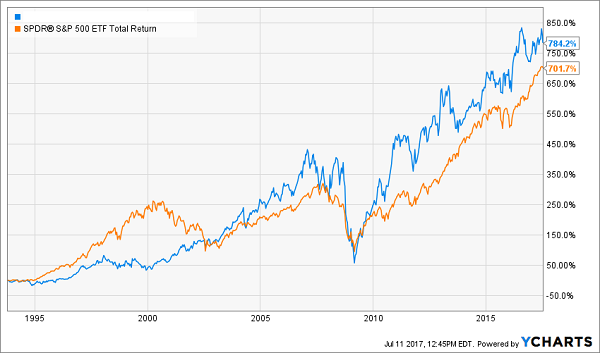
Oh, and this fund also paid out a rock-solid 7%+ dividend the whole time.
If that’s not worth paying a premium for, I don’t know what is!
But as I write, this dynamic fund is still trading at a big discount to its net asset value (NAV), or the value of its underlying assets, even though it pays a gaudy 7.8% dividend yield!
This one has traded at big premiums to NAV within the past four years, and I fully expect it to do so again … handing us a nice 20%+ in price upside when it does!
This is one of the 4 terrific—and totally ignored—CEFs I’ll tell you all about in my new FREE report, “4 Great CEFs to Buy Now: 7.5% Yields and 20% Upside Ahead.”
Your copy of this special report is waiting for you now. CLICK HERE and I’ll give you this eye-opening guide FREE and show you all the ins and outs of my secret CEF strategy.
